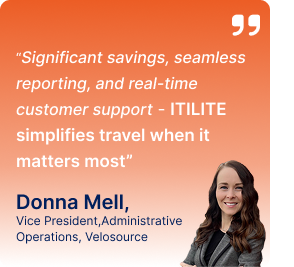
Ensuring a smooth and satisfying travel experience is crucial for any corporate travel program. However, despite best efforts, some travelers will inevitably be unhappy during their journeys. As a travel manager, dealing with unhappy travelers is critical to providing high-quality service and maintaining traveler satisfaction.
Unresolved traveler issues can quickly escalate and negatively impact your company’s operations and budget. Dissatisfied travelers may be less productive during their trips, complain to management, or even look for another job. Furthermore, negative experiences can deter engagement in future travel programs.
This article will explore techniques to identify causes of unhappiness, provide meaningful solutions, and recover traveler satisfaction when things go wrong. Implementing these strategies can turn frustrating situations into opportunities to improve processes.
Identify the Cause of Unhappiness
As a travel manager, you must manage the impossible task of keeping all business travelers happy throughout their journeys. People become unhappy for various reasons, primarily due to external factors they have little control over. Knowing the common reasons for traveler unhappiness can help you address their problems correctly.
Delays and cancellations are major business travel frustrations beyond your control. Discomfort during flights, whether from small seats, noisy cabins, or other annoyances, can also make travelers unhappy. While you may not be able to expand legroom, you can book preferred seats when possible.
Further, upon arriving at their destination, hotel issues like incorrect reservations, uncomfortable beds, noisy rooms, or unhelpful staff often upset business travelers. Although the hotel is responsible for service issues, you must intervene on the traveler’s behalf to get problems resolved.
You’ll encounter multiple such situations, but here are five primary ways to solve them.
1. Empathize and Listen
When you have to deal with unhappy travelers, it’s important not to get defensive. Let them fully express their frustrations and concerns without interrupting. Pay close attention to what they say and make it clear through your words and body language that you understand where they are coming from. Phrases like “I can understand why you feel that way” demonstrate empathy.
Resist any urge to argue about their perspective. Even if you feel their complaints are unjustified, recognize this is their experience. Validating their feelings will help diffuse the conflict and show that their dissatisfaction matters to you.
Let the traveler vent until they have fully said their piece. You lay the groundwork for finding a mutually agreeable solution by listening patiently and acknowledging their perspective without judgment. Jumping into problem-solving mode too quickly can make them feel unheard. Show you care about their experience first and foremost.
2. Take Ownership and Apologize
Even if the source of a traveler’s unhappiness is not your fault, taking ownership of the situation and offering a sincere apology is essential. This helps diffuse tension and shows the traveler you care.
Next, avoid making excuses or defending processes and policies. The traveler just wants to feel heard and acknowledged in that moment. Simply say, “I understand why you are upset, and I am truly sorry we did not meet your expectations. This is not the experience we aim to provide.” Tell them you will do everything you can to make it right. While corporate travel policies and procedures are in place for good reason, short-term flexibility and empathy for the traveler can go a long way.
Taking ownership reinforces that you are on the traveler’s side and share the goal of a joyous business travel experience. It opens the door to finding a constructive resolution.
3. Provide Solutions to Manage Unhappy Travelers
When travelers experience issues or disruptions, responding quickly with solutions can help rectify the situation, rebuild trust, and restore satisfaction. Try focusing on practical solutions and alternatives rather than just apologies. Some good strategies include:
- Offer options and alternatives: If a traveler’s original flight, hotel, or transportation is canceled or unavailable, research and present other options. Providing choices gives them back a sense of control.
- Compensation or refunds: Depending on the situation, offering monetary compensation like refunds, credits, or reimbursements can help offset inconveniences. Set clear policies on compensation.
- Route travelers to solutions: Empower frontline staff to solve simple requests directly, like booking new arrangements. For more complex issues, route travelers to managers or agents who can dig deeper to find solutions.
- Find ways to upgrade: When feasible, upgrade travelers to better room types, seat classes, or services than initially booked. These comfort-enhancing perks help smooth over frustrations.
- Meet special requests: Do your best to accommodate requests within reason, like room location, meal options, and seating arrangements. Fulfilling requests shows you’re listening.
- Provide amenities: Small touches like snacks, Wi-Fi, lounge access, or parking vouchers demonstrate you care about the traveler’s overall experience.
Focusing on prompt, practical solutions is essential for turning unhappy employees into satisfied ones. Empower staff to solve issues on the spot whenever possible.
4. Act Quickly and Decisively
Empower your team to take decisive steps like booking new flights, arranging hotel accommodations, or providing meal vouchers—set procedures so staff can immediately assist without needing extensive manager approval. Employees will be grateful for swift solutions, even if initially upset.
When you deal with unhappy travelers, it’s essential to act fast to resolve the issues at hand. As a travel manager, you must have the authority to make prompt decisions to appease unhappy employees. Don’t delay taking action, as this will only increase frustration.
Decisive service recovery turns angry travelers into satisfied ones. Negative situations become positive when problems get rapidly resolved.
5. Follow Up Afterwards
After resolving an unhappy traveler’s issue, it is essential to follow up with them afterward to ensure the resolution is satisfactory. Here are some tips for following up effectively:
- Check-in later to confirm the issue is resolved. Don’t just assume the issue is resolved right after providing the initial solution. Check with the traveler in a day or two to confirm the resolution met their needs. This shows you care about their experience.
- Request feedback: Ask the traveler how you and your team handled the situation. Listen openly to their perspective and apologize again if anything could have been done better. Feedback will help you improve policies, procedures, and staff training.
- Thank them for their patience: The follow-up is an excellent opportunity to thank the traveler for their patience and understanding during the disruption. A little courtesy and gratitude after the fact can smooth over frustration.
- Offer compensation if appropriate: If the traveler endured significant hardships and disruptions, consider offering them loyalty program points, future travel credits, meal vouchers, or amenity gifts. This demonstrates your aim to make it right.
- Check if additional help is needed: Ask if they require any additional assistance related to the incident, like rebooking missed connections, obtaining reimbursements, or gathering documentation. Assure them you’re available to help.
What to do After the Trip is Completed?
After each unhappy traveler interaction, take time to analyze what went wrong and determine the root causes of the issues. Look for patterns and systemic problems that led to the traveler’s dissatisfaction. Some potential areas to review include:
- Travel booking policies: Are the rules too restrictive or ambiguous? Do they provide enough flexibility for travelers?
- Approval processes: Are there bottlenecks or delays in getting approvals that impact travel plans?
- Vendor policies: Do contracts with hotels, airlines, or other vendors penalize travelers unfairly?
- Traveler support: Is support readily available when issues arise on a trip? Are travelers given adequate points of contact?
- Communication of policies: Are travel policies clearly explained to employees? Is essential information accessible for travelers to find?
By pinpointing problematic policies, approval processes, contracts, or communication issues, you can make targeted changes to prevent the same problems from recurring.
Revise policies and procedures accordingly, then educate travel managers and travelers on the updates. With continuous improvement of the travel program, you can better meet traveler needs and minimize dissatisfaction over time.
Conclusion
Any travel management team must manage unhappy travelers. It’s crucial to deal with unhappy travelers by addressing issues and providing swift solutions. This not only improves the travel experience for your employees but also strengthens your company’s reputation.
Adopting corporate travel management software such as ITILITE significantly reduces the likelihood of errors in travel planning. This robust tool streamlines the entire process, making business travel planning remarkably efficient. The result? An elevated travel experience that ensures happy and satisfied travelers. With ITILITE, you’re not just organizing trips; you’re empowering your team with a journey that leaves them delighted and focused on their goals at every step.
Book a free demo today and know how you can manage unhappy travelers.













